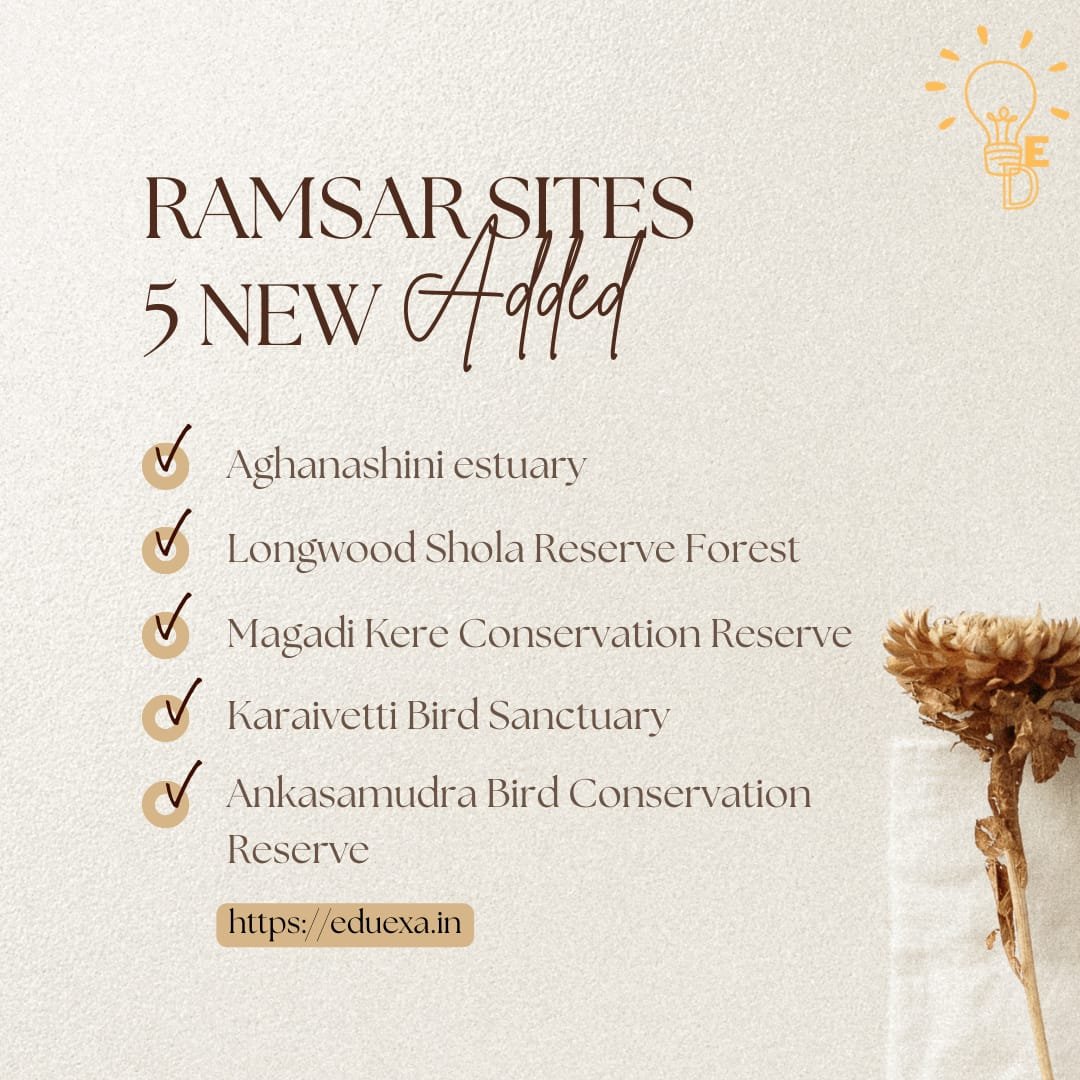Ramsar Sites in India UPSC | Newly added Ramsar Sites
5 New Wetlands added to Ramsar Convention
Ramsar Sites in India has now increased from 75 to 80 with addition of following new wetlands to the list:-
Ankasamudra Bird Conservation Reserve -Karnataka
It plays a crucial role in the conservation of avian species and their habitats. Spanning across an area of approximately 8 square kilometres, this sanctuary is a haven for avian enthusiasts and nature lovers alike.
It is widely known for its rich bird diversity: some 35,000 birds of 240 species have been recorded, of which about 30 waterbird species breed at the Site.
There are also nine endemic fish species, three of which are globally endangered: tiger loach (Botia striata), aruli barb (Dawkinsia arulius) and nukta (Schismatorhynchos nukta).
The sanctuary serves as a vital habitat for several endangered and threatened avian species, such as the painted stork, spot-billed pelican, Indian peafowl, and grey-headed fish eagle.
Read the outcomes of COP28 here.
Aghanashini Estuary – Karnataka
The Site is an estuary where the Aghanashini River flows into the Arabian Sea in Karnataka State.
In addition to its estuarine and shallow marine waters, it features rocky and pebble shores, intertidal mudflats and some aquaculture ponds and rice fields.
These diverse environments provide habitats to more than 80 fish, 115 birds and 45 mangroves and mangrove-associated species, including globally threatened species such as halavi guitarfish (Glaucostegus halavi), lesser adjutant (Leptoptilos javanicus) and Indian river tern (Sterna aurantia).
A majority of the fish species found at the Site are able to adapt to a wide range of saline environments, while some are migratory and only enter the Site for spawning or during early life stages. About 55,000 individual birds and more than 1% of the regional populations of nine bird species have been recorded here, including almost 10% of the regional population of black-headed ibis (Threskiornis melanocephalus).
The Site supports the livelihoods of more than 6,000 households, who are engaged in activities such as fishing, agriculture, shrimp aquaculture, bivalve shell mining and salt production. In the estuary, farmers practise traditional farming to grow a salt-tolerant rice called “kagga”, which is one of the specialities of the region.
Magadi Kere Conservation Reserve – Karnataka
It provides stable habitat conditions for more than 165 bird species and has been declared an Important Bird and Biodiversity Area (IBA).
Rare and threatened species such as the northern shoveler (Anas clypeata), garganey (Anas querquedula) and common pochard (Aythya ferina) are found here.
Some 30,000 waterbird individuals including 8,000 wintering individuals have been regularly recorded; the Site is one of the largest wintering grounds for bar-headed goose (Anser indicus) in southern India.
Karaivetti Bird Sanctuary – Tamil Nadu
It is one of the largest inland freshwater lakes in the State of Tamil Nadu, providing an important stopover and foraging ground for birds migrating along the Central Asian Flyway.
Some 10,000 individuals of 14 colonial waterbird species have been found nesting here.
The gum Arabic tree (Acacia nilotica) provides roosting and nesting grounds for threatened species such as spotted eagle (Aquila clanga), tawny eagle (Aquila rapax) and Indian darter (Anhinga melanogaster).
The Site also provides breeding habitat for the vulnerable Indian flap-shelled turtle (Lissemys punctata).
Longwood Shola Reserve Forest – Tamil Nadu
It features intermittent freshwater marshes and streams nested within a “shola”, a tropical montane forest of southern India.
It has very high species endemism: around 40 species of trees, four reptiles, 14 frogs and 14 birds that are endemic to the Western Ghats region are found here. The Site is one of the key conservation areas of the endangered black-chinned Nilgiri laughing thrush (Strophocincla cachinnans), the Nilgiri blue robin (Myiomela major) and the vulnerable Nilgiri wood-pigeon (Columba elphinstonii).
reference from https://www.ramsar.org/country-profile/india



